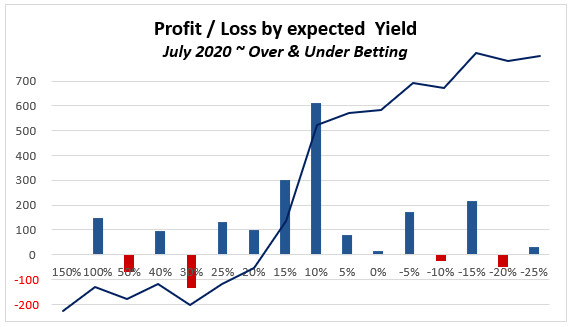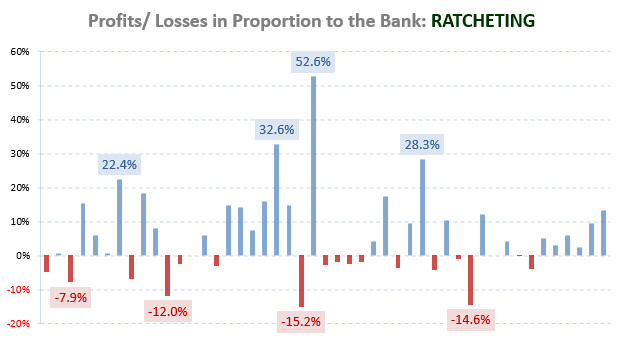
In conjunction with our regular match previews published in the German Betfair blog we are pleased to present our league match with head-to-head history ‘Value’ bet detector spreadsheet.

with H2H History
WITH Asian Handicap
(ex VAT; see below)

WITHOUT Asian Handicap
(ex VAT; see below)

0% VAT to UK customers
0% VAT to Non-EU customers
Read more: EU VAT Legislation
e-shop: Product Overview
View Your Shopping Cart
Our bet selections are always based on true odds calculations identifying mathematical ‘value’ in the markets. Of course, not every bet can win, but ‘value’ betting is the only reliable method of ensuring long-term betting profits.
‘VALUE’ bet detector: The Excel spreadsheet calculates the ‘true’ odds (= expected probabilities based on historical statistics) and then displays each ‘value’ bet recommendation. For every event included the expected values are calculated, compared to market prices, and finally the statistical probability of winning the bet is shown.
Soccerwidow follows the philosophy that only through identifying bets containing mathematical ‘value’ in the prices offered by bookmakers or exchanges is it possible to make consistent profits.
It should be noted that the spreadsheet is not a tool for automated betting. The tables provide vital information to improve the accuracy of your own predictions, and the figures do not substitute for reading salient news and applying good judgement.
The Excel spreadsheet offered for sale comes pre-filled with data from the Premier League game Liverpool v. Manchester City on 26/8/2012. Just delete or over-type this to analyse any match of your choosing.
Read a few sample match previews which apply ‘League Games with H2H History’ calculations:
- 26.8.2012 English Premier League: Liverpool v. Manchester City – Statistical Match Analysis & Football Betting Predictions
- 6.8.2012 Norwegian Tippeligaen: Stabæk v. SK Brann – Statistical Match Analysis & Football Betting Predictions
- 5.8.2012 Belgian Jupiler League: Zulte-Waregem v. Gent – Statistical Match Analysis & Football Betting Predictions
Notes: Adjust the picture quality at the bottom of the screen above by clicking on the ⚙ button (to the left of the YouTube logo), then click on ‘Quality’ and choose a higher resolution as desired. Go to full screen mode by clicking on the box symbol (to the right of the YouTube logo).
Supporting Videos
Data Sourcing: Learn where to find historical match data and download it from www.football-data.co.uk to make your own Excel store of statistics.
Data Input: Historical match results and head-to-head data input to populate the Value Bet Detector ready for input of the best odds you can find.
Frequently asked questions:
Can I use the spreadsheet in other leagues?
Yes, the calculations apply for any league in the world. The only parameters are that the game in question must be between two teams which have played at least their last 25 home or away games in the same league. The calculations are based on the home team’s last 25 home games and the away team’s last 25 away games, in the same league. Also, both teams must have played the corresponding fixture at least 6 times in the last 10 years (in other words, the home team has hosted the away team at least 6 times in all competitions (not friendlies) in the last 10 years).
How long does it take to enter historical data into the spreadsheet?
This is a manual procedure and you will quickly find which sources are best for the full-time and half-time results of both teams in the 25 matches to be analysed, plus the head-to-head encounters. We recommend Football-Data, Betexplorer, Oddsportal and Soccerway, although there are a host of other sites specialising in historical statistics.
At the start, you will find data collection will take about 30 minutes per match including entering the best bookmaker odds you can find (try Betfair and Oddschecker).
Are the formulas for the spreadsheet calculations visible?
Yes, we have hidden none of the formulas.
Exactly which historical records do I have to input?
The full-time and half-time scores for both team’s last 25 matches (home games only for the home team, away games only for the away team), plus the same for the head-to-head encounters over the last 10 years.
What knowledge is required?
You should already have a understanding of odds and how they are calculated. The spreadsheet is just a tool to identify potential bet candidates. You will need to understand what is meant by the term ‘value’ and also have a good idea how to spread risk with a well-structured betting portfolio. The spreadsheet is intermediate level, and you should be become entirely familiar with its mechanics before committing money to any bet recommendations suggested by the spreadsheet.










Hello Mahendra,
Answering your questions in order:
1) If the match in question has less than six head-to-head (H2H) competitive meetings at the same ground in the last 10 calendar years immediately preceding the date of the match you are analysing, then do not use the Value Calculator in this case. Pick only games with at least six H2H encounters. Use http://www.betexplorer.com to find this out quickly. Here’s a link to the game you mentioned showing all the meetings at Old Trafford (since 1999/2000 in this case): http://www.betexplorer.com/soccer/england/premier-league/mutual-matches/?home=ppjDR086&away=WSzc94ws&where=1
With cup games, take only the results as they were after 90 minutes – don’t include extra time or penalties. 10 years to the day would include all the results shown in Betexplorer up to the 0-0 draw on 14.04.2006 – no need to enter any earlier games than this. There are therefore nine games to include on the H2H tab – all matches from 14.04.2006 to the most recent on 03.05.2014.
2) With new entrants to any league it is difficult to fulfill the criteria of last 25 matches in the same league for the home and away tabs. In the case of the EPL, you will find that games between two new entrants can be entered safely in the Value Calculator as both will have played in the same league (The Championship) last season. Remain consistent and never mix data.
3) There is no best time to enter odds as the Value Calculator is based purely on historical statistics. The best time is whenever you are ready to input the odds you have at your disposal as these will provide you with the probabilities and value calculations at that moment in time. If the odds change before you place your bet, then change them in the Value Calculator to see if the values remain positive. Any value above zero is good if you are using bookmakers only, but if you are using a broker or a betting exchange, you must account for the level of commission being charged and only pick potential bets with value over and above the rates of commission you are being charged.
4) Column AH automatically updates when you have entered all the required information. Column AG is a manual override facility if you want to force the calculator to show you probabilities and value. Just type “back” or “lay” (without the speech marks) into column AG when the calculator does not flag up anything in column AH.
Hope this helps.
Some questions please.
1) I want clarify what the situation is if both teams have less than six H2H statistic
2) Does the chart work for teams that are new to the league
3) When is the best time to enter odds and analyze?
4) Does column AG and AH automatically populate when you enter the odds?
Many thanks.
thanks for your in depth reply
i will purchase the O/U course in the next few days
thanks
Hi Pico,
Thanks for your questions. The Value Calculator (VC) relies upon a smaller data set – the last 25 respective league home and away games of the two teams involved. There is also the inclusion of head-to-head (H2H) results between the two teams in the same fixture over the last 10 calendar years, with the proviso that there must be at least six such results to make the spreadsheet calculations valid. (In other words, the match analysed must contain at least six H2H meetings in all competitions excluding friendlies – don’t use the VC in cases where there are insufficient H2H data.
The H2H data helps add significance or weight to the calculations and sometimes you may find H2H results are also included in the home and away statistics of both teams (i.e. they may have played each other in this same fixture within their last 25 respective home or away league games).
So, as the VC is a snapshot of statistics, it does not employ the same methods as the Over/Under course, which is a more thorough but also more time-consuming method of odds calculation.
The VC provides a solid benchmark to use to identify probabilities of future events occurring and the mathematical value included in any bets flagged up by the VC, or indeed those you are consistently interested in.
The VC has been put together with four years of analysis, and comparing the results with the actual odds available in the market, the accuracy rate of the VC is between +/-3% and +/-5%, depending on the bet type. With this degree of accuracy, it gives a reliable platform to compare current odds with historical statistics and provide you with serious betting options.
The VC contains just the formulas – if we were to explain how the true odds are calculated in words, we would be here until next Christmas (sorry!).
We have tried to make it easier for you to comprehend odds calculation with the introduction of our Home, Draw, Away, Favourite and Underdog (HDAFU) tables, which are statistical works of art and as such, would fall into the category of more advanced product. Watch out in the next few days as we put the latest batch of these on the site for sale…
Best regards.
hi soccerwidow
does this product explain how the true odds are calculated or does it just give the formulas??
i like the tool but am also interested in where the numbers come from…
thanks
hi soccerwidow
i am very interested in your true odds calculations.
are they calculated in this product the same way as in the O/U course??
And if so have you a more advanced model/product for more accurate odds?? ie. different variables
thanks and keep up the good work😊
Thanks for your quick answer 🙂
Hi R82,
The Apertura (opening) and Clausura (closing) are just two halves of a complete ‘season’ in many South American leagues.
You should use the last 25 home games for the home team and the last 25 away games for the away team regardless of whether the run of games came in the Apertura or Clausura, or both (which is more likely as the largest leagues of this nature contain only 20 teams).
Essentially the data you will use comes from the same ‘league’ and it doesn’t matter which half produces the larger portion of your 25 game complement.
I hope this helps and thanks for your question. Good luck!
I have the sheet for a while now but didn’t had any time to use it. Last weeks i did some tests whit it and it looks like this could be a handy tool to add to my analysis. I was wondering if i can use this sheet also for south american competitions who are working with apertura and clausura? Do i have to use the last 25 home games in the apertura for example or can i take the last 25 home games of apertura and clausura together?
In the video you said that
2,94+11,00 aver. is 4,64
How come when is 6,97
Please find an explanation of the calculation of average odds here: How to Calculate Average Odds in Football Betting
Hi Soccerwidow, I’ve been using this calculator for a while, so far has been a hit and miss; the biggest issue I had it’s the variance, from month to month even choosing the same kind of bets and probability clusters (flat stake mostly asian handicap and over/unders with 65-75%) the results differ a lot. The earnings from a good period are lost in the following month and so on, after nearly 400 bets it’s hard to break even.
Maybe I’m missing something or using an older version of this spreadsheet, but sometimes I feel this is pure luck. Also I think when it comes to bigger leagues as EPL, La Liga, Serie A it’s very difficult to have an edge against the bookies, they have too many sources and information, they won’t commit mistakes that easily in those markets; for example it doesn’t matter if an underdog it’s “value” priced generally they know very well in advance why they’re publishing those odds. Perhaps the biggest amount of money in these leagues and some others mostly comes from arbitrage betting and it could explain the irrational odds movements pre match, that’s a theory a I have.
Finally, I’d like to discuss when you say that this is only a numeric tool (which I agree) but then you add to “pick the bets you feel are right for you”; in my opinion picking the bets you consider the winners without any numeric calculation, it’s basically betting by gut feeling. For example it doesn’t matter if this spreadsheet tells me that Parma +1.5 (1.82 in Pinnacle) has 70% probability against Napoli if I’m certain that Napoli it’s going to trash Parma which is having a terrible season by 2, 3 or even more goals? what I should trust in that case, the numbers or my perception?
I would like to read your answer.
P.D: By the way, Parma lost 2-0; according to the calculator Napoli -1.5 had 30% of probability and was priced 2.14 in Pinnacle right before the game, I lost many bets like this.
Hi Jozef,
Thanks for taking the time and trouble to comment.
Having analysed over 750 matches with the Value Calculator in various worldwide leagues, we find the algorithms accurate to within +/-5% on most bet types, with others performing even better.
When we get to 1,000 matches analysed we shall publish the results and this in turn may lead to one or two of the algorithms being tweaked. It may even lead to individual calculators for certain leagues, but 100 spreadsheets is probably too few to be able to make firm judgments. 100 games in the Bundesliga does not even represent a third of a whole season – the more stats you have, the more reliable information extracted from them becomes.
Please don’t get caught in thinking that the calculator is an automated bet picking tool. All it does is give you numerical information regarding the probabilities of outcomes occurring and whether or not they contain value.
Once you have this information to hand, it is then necessary to pick the bets you feel are right for you. You might want to place bets only on outcomes where the calculator has indicated a 75% probability of success, or higher.
Concentrate on the probabilities and then look to see if the bet carries value. Even if the value is negative, in the long run you may still turn a profit backing 75% chances.
If you are going to work on specific algorithms for the Bundesliga then it would be great to hear from you again with any findings you may discover. We can then trawl through our data and confirm whether or not you are on the right track.
Hope this helps and thanks again for your interest in Soccerwidow.
Hi Soccerwidow,
i’ve tried the spreadsheet and I´ve got interesting results. In some leagues are the odds very similar to odds of bookmakers, but in some ligue f.e. germany bundesliga is your algoritmus for setting of “true odds” very dubious. I made backtesting in more than 100 matches, which I choose value regads your algoritmus (matches with big value),but I have to say, I would lost a lot of moeny, if I use your algoritmus.
50% weight for h2h is relly optimistic and I am sure, that bookmakers don´t give so big weight for H2h by setting the odds.
Nevermind, I like your website 🙂
Hi Soccerwidow and Soccerwidow’s Bloke :),
I want to find historical data for the Denmark League can you help me please as soon as possible. I cant find historical excel sheet data about the Denmark league anywhere.
If you could help I would really appreciate it 🙂
Thank you 🙂
Hello again Mike,
As I’ve just mentioned in my last post, we find the most relevant sample for statistical significance is 10 calendar years of competitive H2H results (no friendlies) prior to kick-off. In other words, historical games between the two teams you are analysing which took place at the ground of the home team. We also set a minimum figure of six H2H’s in that 10 year period – if the teams have played less than six H2H’s in the last 10 years then we do not analyse the game. The H2H record is the first thing we look at when deciding upon match selection.
H2H history is a great leveller. You can see the effects on the odds once you’ve inputted the historical data. Enter the two teams’ data first and then look at the main Value Calculator tab. Notice the odds and compare them with what is being offered in the market. Then fill-in the head-to-head data. Look back at the VC tab and you’ll find the effect the H2H results have.
In the Value Calculator, averages are compared with averages. Analyse three home games in a row for a particular team and you won’t see much difference in the odds and probabilities suggested because much of the same data is used for the first match back as opposed to the third match back. It’s the same for the away team. It’s the same for the H2H’s. All of this data is only used to define what an ‘average’ game (in terms of numbers) between the two teams would look like if the match played out to recent form.
H2H data also helps build a picture of how the two teams in question have played against each other in past. If the home team holds a hoodoo over the away team then this factor is built in to the values and probabilities shown in the calculator. It has a ‘smoothing effect’ and is the only data directly relevant to matches between the two teams. With data this important, why would you not include it in your calculations?
Don’t forget, the Value Calculator is a tool to give you the numbers in advance of a situation. You cannot influence the match outcome, but looking back at the past in order to interpret what may happen in the future is the only way of setting odds. This is the way bookmakers operate, so in order to compete, you must join them.
Mike, I hope this helps!